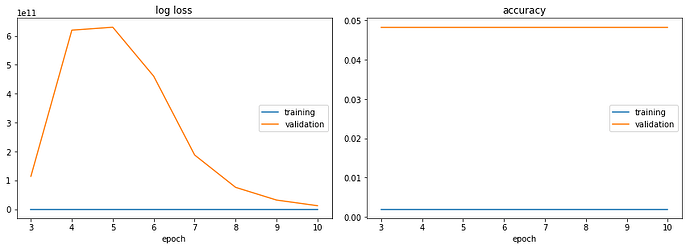data_transforms = {
‘downsampled’: transforms.Compose([
transforms.RandomResizedCrop(224),
transforms.ColorJitter(brightness=0.5),
transforms.RandomHorizontalFlip(),
transforms.ToTensor(),
transforms.Normalize([0.485, 0.456, 0.406], [0.229, 0.224, 0.225])
]),
‘d_valid’: transforms.Compose([
transforms.Resize(224),
transforms.ToTensor(),
transforms.Normalize([0.485, 0.456, 0.406], [0.229, 0.224, 0.225])
]),
}
data_dir = ‘down_sample’
image_datasets = {x: datasets.ImageFolder(os.path.join(data_dir, x),
data_transforms[x])
for x in [‘downsampled’, ‘d_valid’]}
dataloaders = {x: torch.utils.data.DataLoader(image_datasets[x], batch_size=16,
shuffle=False, num_workers=4)
for x in [‘downsampled’, ‘d_valid’]}
dataset_sizes = {x: len(image_datasets[x]) for x in [‘downsampled’, ‘d_valid’]}
class_names = image_datasets[‘downsampled’].classes
device = torch.device(“cuda:0” if torch.cuda.is_available() else “cpu”)
#lets train the model
def train_model(model, criterion, optimizer, scheduler, num_epochs=5):
since = time.time()
best_model_wts = copy.deepcopy(model.state_dict())
best_acc = 0.0
for epoch in range(num_epochs):
print('Epoch {}/{}'.format(epoch, num_epochs - 1))
print('-' * 10)
# Each epoch has a training and validation phase
for phase in ['downsampled', 'd_valid']:
if phase == 'downsampled':
scheduler.step()
model.train() # Set model to training mode
else:
model.eval() # Set model to evaluate mode
running_loss = 0.0
running_corrects = 0
# Iterate over data.
for inputs, labels in dataloaders[phase]:
inputs = inputs.to(device)
labels = labels.to(device)
# zero the parameter gradients
optimizer.zero_grad()
# forward
# track history if only in train
with torch.set_grad_enabled(phase == 'downsampled'):
outputs = model(inputs)
_, preds = torch.max(outputs, 1)
loss = criterion(outputs, labels)
# backward + optimize only if in training phase
if phase == 'downsampled':
loss.backward()
optimizer.step()
# statistics
running_loss += loss.item() * inputs.size(0)
running_corrects += torch.sum(preds == labels.data)
epoch_loss = running_loss / dataset_sizes[phase]
epoch_acc = running_corrects.double() / dataset_sizes[phase]
print('{} Loss: {:.4f} Acc: {:.4f}'.format(
phase, epoch_loss, epoch_acc))
# deep copy the model
if phase == 'd_valid' and epoch_acc > best_acc:
best_acc = epoch_acc
best_model_wts = copy.deepcopy(model.state_dict())
print()
time_elapsed = time.time() - since
print('Training complete in {:.0f}m {:.0f}s'.format(
time_elapsed // 60, time_elapsed % 60))
print('Best val Acc: {:4f}'.format(best_acc))
# load best model weights
model.load_state_dict(best_model_wts)
return model
model_1 = models.resnext50_32x4d(pretrained=True)
num_ftrs = model_1.fc.in_features
model_1.fc = nn.Linear(num_ftrs, 13)
model_1 = model_1.to(device)
criterion = nn.CrossEntropyLoss()
Observe that all parameters are being optimized
optimizer_ft = optim.Adam(model_1.parameters(), lr=0.001,weight_decay=0.4)
Decay LR by a factor of 0.1 every 7 epochs
exp_lr_scheduler = lr_scheduler.StepLR(optimizer_ft, step_size=7, gamma=0.1)
